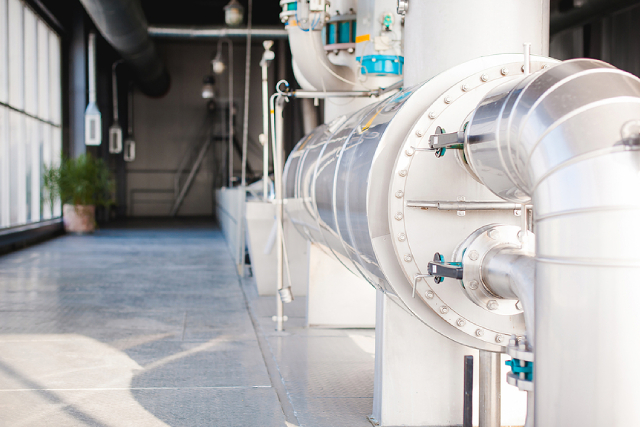The Lowdown On Vacuum Conveying Systems And How They Work

Every industrial plant across various sectors shares the need for an efficient way of moving dry materials throughout their processes. For many such organisations, vacuum conveying has become their top choice to scale up production.
Below, we go over the whys and hows of vacuum conveying systems, their two common types, and the key considerations prior to implementation.
What Is a Vacuum Conveying System?
Fundamentally, vacuum conveying systems are suction-based machinery that work in the same way that an everyday wet-and-dry vacuum cleaner in Singapore does. They leverage the principle of air velocity and negative pressure to create a vacuum environment that generates pressure differences capable of pulling or ‘moving’ materials.
The negative pressure generated by the system’s vacuum pump in Singapore creates an air stream that transports materials—typically dry powders or granules—along the pipeline toward a designated collection point. This method is highly efficient and, due to the system's closed design, minimises contamination risks and keeps materials isolated from external elements. The latter advantage makes these systems essential for certain industries where material purity and safety are paramount.
Another benefit of vacuum conveying is it ensures less material loss. For instance, if there is a leak in the pipe network, it won’t expel the ambient atmosphere (and the material along with it) outward but rather inward, preventing wastage and creating a dusty mess. Nowadays, vacuum conveying systems are ideal for large-scale applications where dry materials are fed from railcars, silos, and other bulk containers thanks to their ease of installation, energy efficiency, and self-cleaning properties.
What Are the Types of Vacuum Conveyors?
The two most prevalent types of vacuum conveyors available today are:
Dilute Phase Vacuum Conveyors
Dilute-phase vacuum conveyors use high-velocity air streams to keep materials in suspension as they travel through the conveying line. These conveyors operate with low-pressure air, which is particularly effective for materials that don’t compact easily, like grains, powders, or certain chemicals. In the context of the vacuums in the chemical industry, these systems are crucial for safely transporting fine chemicals and powders. Due to their fast-moving air, dilute-phase systems can transport materials over long distances, but the significant forces they impart may cause abrasion or damage to fragile products.
Dense Phase Vacuum Conveyors
In contrast, dense phase systems operate at lower velocities with higher material-to-air ratios, making them suitable for delicate or abrasive products. By moving materials in dense packets (or slugs) at a controlled, slower speed, these conveyors help preserve the integrity of fragile materials like certain food items, pharmaceuticals, and chemical powders. Dense-phase vacuum conveyors are also more energy-efficient and minimise wear on the piping and equipment, making them ideal for applications where product quality is critical and mitigating dust and contamination is important.
How Vacuum Conveyors Are Used in Various Industries
- Pharmaceuticals
In the pharmaceutical industry, vacuum conveyors are commonly used for safely transporting powders, granules, and capsules. These systems help maintain hygienic standards and prevent contamination, which is crucial for drug safety and compliance.
- Food and Beverage Processing
Vacuum conveyors are integral in transferring dry ingredients such as powders, grains, and sugar in food manufacturing. They enable sanitary handling, reducing airborne particles and ensuring no contamination occurs. These systems also prevent cross-contamination between ingredients, a critical factor in food safety.
- Battery and Electronics Manufacturing
Vacuum conveyors are utilised to transfer fine powders, such as lithium, graphite, and other materials used in battery production. This application helps maintain precision and cleanliness while reducing manual handling, which is essential in industries requiring highly controlled environments.
Considerations When Opting for a Vacuum Conveyor System
When deciding to implement a vacuum conveyor system, it’s essential to evaluate several key factors first:
1. Operational requirements
Understanding the method of material movement is essential for selecting the correct system. As covered above, vacuum conveyors typically support either batch or continuous feeding. Batch feeding allows precise quantities of material to be delivered at set intervals, making it ideal for controlled, time-sensitive applications. Continuous feeding, on the other hand, supports a steady flow and is suitable for processes where consistent material input is critical.
2. Material characteristics
The properties of the material being conveyed—such as flowability, temperature sensitivity, abrasiveness, and moisture content—can significantly affect system performance. For example, abrasive materials may cause wear on conveyor components, while high moisture content could impact flow. Analysing these characteristics in combination allows for a more accurate assessment of the system’s suitability and ensures reliable material handling.
3. Space and installation constraints
The available footprint for installation can influence the choice of system design. Key factors include discharge elevation, inlet positioning, and spatial dimensions. This consideration is especially important when integrating the vacuum conveyor into existing production lines, where compatibility with current equipment may dictate layout adjustments.
4. Environmental conditions
Environmental factors also play a role in system selection. The presence of dust, potential ignition sources, or corrosive agents may require additional safety measures, such as explosion-proof or corrosion-resistant designs. Understanding these conditions ensures the chosen system can operate safely and effectively within the specific environment.
Conclusion
Vacuum conveying systems are essential for efficient, safe, and hygienic material handling across various industries. By considering factors like material properties, operational needs, and environmental conditions, businesses can choose the most suitable system for their needs, enhance productivity, reduce costs, and ensure safety.

